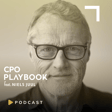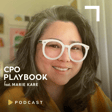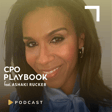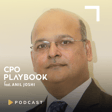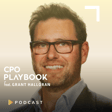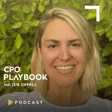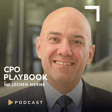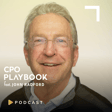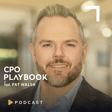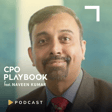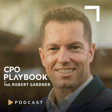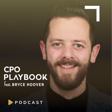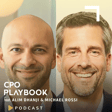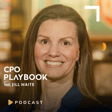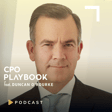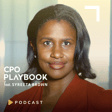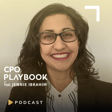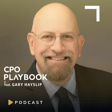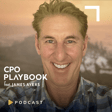Become a Creator today!Start creating today - Share your story with the world!
Start for free
00:00:00
00:00:01

HR Technology Conference on AI and More (Part 1)
In this exciting episode, we’re bringing you the highlights from the HR Technology Conference right from the vibrant floor of Las Vegas! Join us as we delve into the latest innovations, trends, and insights that are reshaping the HR landscape. From cutting-edge AI solutions to a myriad of transformative technologies, we explore how these advancements are revolutionizing the way businesses manage their workforce. Tune in to discover the most impactful HR trends, best practices, and analytics that are defining the future of HR technology.
Transcript
Introduction to CPO Playbook Podcast
00:00:04
Speaker
Hello everyone. I'm Felicia Shakiba, and you're listening to the CPO Playbook Podcast. Join me and my guests as we feature insightful conversations with HR leaders, people scientists, and executives from diverse industries and functions, offering valuable perspectives on the future of work.
Strategies for Modern Work Complexities
00:00:23
Speaker
Discover a unique outlook on navigating the complexities of the modern-day working world. Exploring innovative strategies in talent management and corporate culture from the chief people officer's perspective. Tune in to stay ahead of the game when it comes to all things people related.
HR Tech Conference Overview
00:00:44
Speaker
Welcome to a thought-provoking journey into the heart of HR innovation at the HR Tech Conference in Las Vegas, exploring an array of cutting-edge solutions with AI as a significant cornerstone. Today we have the privilege of engaging with a diverse range of HR Tech vendors, specializing in HR information systems, candidate experience, learning and development platforms,
00:01:11
Speaker
performance management, compensation, and so much more. Our discussions will unveil the innovative solutions that these vendors provide, shedding light on the critical problems they're solving, and provide a tantalizing glimpse into the boundless possibilities they see for the future. But that's not all. This episode is poised to illuminate the real world applications of AI.
00:01:37
Speaker
showcasing how it's revolutionizing the way we find, develop, and retain talent. So buckle up as we venture into a realm where human resources and technology coalesce. This is the HR Tech Conference Episode Part 1, and it starts now.
Agent Noon at HR Tech Conference
00:02:00
Speaker
I had the privilege of conducting a second interview with Ali Nawab, who serves as the CEO and co-founder of Agent Noon, a company with the backing of Y Combinator. While the full story of Agent Noon is covered in Episode 9, at the conference, Ali introduces the platform to an extensive in-person audience. With Agent Noon, he unveils a command center, specifically designed for the C-suite.
00:02:28
Speaker
seamlessly connecting financial data with human resources and translating HR insights and organizational design into financial strategies.
AI Trends and HR Solutions
00:02:40
Speaker
What do you see going on at HR Tech? The obvious thing is that every company is in AI companies. I think some of the other things that are maybe less obvious are that a lot of companies are trying to be the one stop solution for all of your HR needs. And at least in my conversations with people, they're
00:02:57
Speaker
getting fairly confused about what that means, because nobody's fully satisfied with what they have. So there's clearly gaps. But if you look at the range of companies presenting, every company is doing analytics. Every company is doing HR, payroll, appliance, employee benefits. And I think we will see a clear separation of companies that are very focused on a specific area. And then they're the general platform, SAP, Oracle,
00:03:21
Speaker
workday type products. The companies that are kind of like neither here nor there, and they're somewhat struggling to articulate their position there. And so what is Agent Noon bringing to the table?
00:03:31
Speaker
Agent 2 is a highly focused product that helps leadership teams make better decisions with their data at the fastest possible rates. So while everybody is selling a point solution to a specific problem that is typically downstream of the HR leader, we are selling a very focused solution with very fast speed and ease of use that is focused on the leadership suite, which the HR person is a critical member of.
00:03:56
Speaker
But it's also the finance leader, the ops people, the CEO, that's where we're focused. And I know that on the episode that I interviewed you and this is really about how Agent Noon brings together the language between
00:04:15
Speaker
the finance and HR functions, where you're marrying quantitative data with organizational design and even perhaps other specific strategies that the Chief People Officer is looking to implement.
Beamable's Work Optimization Tools
00:04:33
Speaker
100%. So the promise of technology is that it's going to help us make better and faster decisions. I think a lot of products and companies are still focused on the automation. We'll just kind of have these things go very, very quickly. But I think if you make bad decisions, having them compound at a fast rate is probably not a good idea. And I think from our perspective, because we meet everybody where they are, we're like a translator in between, it builds a lot of alignment because we're not going to get a finance person to get out of their spreadsheet.
00:05:01
Speaker
We're also not going to get an organizational design person to look out of their org chart, but they all need to work together in unison to be able to deliver outcomes. And that's where we want to speed things up. And so what does the future hold for Agent Nim? That's a great question. I think that we're seeing a lot of changes in the environment. I think those changes will continue to amplify and continue to be more frequent. From our perspective, we want to be the command center for leadership teams to make decisions around their number one.
00:05:29
Speaker
effectively most expensive asset, which is people. We want them to be able to make great decisions about who they have, who they need, where to deploy people. There's a lot of conversation about skills based deployment. I think we're going to start to see separation around problem statements. And I don't see a single CEO, no matter what product
00:05:48
Speaker
they're using who's saying I get all the results I want super fast and then I can do a bunch of what-if scenarios on those results to get where I want to go and be able to adjust my strategy in real time. That's where I think we're going to shine and we're going to really separate ourselves but I think that is a bit of a long journey. I'm excited to be part of it obviously.
00:06:08
Speaker
If there was one thing I was eager to explore during the conference, it was the potential of AI to enhance productivity. That's when I discovered Beamable, a company led by a dynamic Australian female co-founding duo, ex-Google employee Victoria Stewart and Stephanie Roos, who has spent 10 years at CEB.
00:06:32
Speaker
Victoria and I started Beamable because we could see that the current systems for organizing and distributing work were very broken, causing friction points for employees with burnout and high workloads and high stress and friction points for organizations who are struggling to optimize their performance. So we built Beamable work design platform that would help organizations
00:07:02
Speaker
get a view of their current state, a diagnosis of what their current work design is and what the gaps and opportunities are. Provide them with some analysis to show them those hotspots and then help them to improve their work design through a really easy to use interface where they could optimise for the work that people love to do and the work that their organisation need to get done.
00:07:29
Speaker
And as I understand it, you are collecting data around employee activities. And so how do you collect this data? Where does it come from? Great question. So we essentially populate activities with using AI. So that's a really great starting point for organizations.
00:07:50
Speaker
In addition to that, we allow organisations to pulse their people to understand are those activities actually the work that they're doing because often we have a disparity between what a job description says and what activities people are actually doing in their work.
00:08:07
Speaker
We also invite them to add hours to their activities to recognise how much time they're spending against them. And then there's a series of questions that helps categorise the work. So, Steph mentioned before around what work is really energising, what do they love, so they have an opportunity to select which activities they really enjoy doing. We might ask them what work is aligned to the organisation or goals. And this is all customisable, but it really allows for organisations to understand
00:08:36
Speaker
the nature of the work that people are doing and invite a bottom-up response from their workforce as well. And what I think is really interesting of what you guys are doing is that you're able to, from a very high level, if you're an executive, beam down into someone's work and really understand where they're putting their time, which I think is incredible because from a high-level perspective,
00:09:05
Speaker
It's very hard to do that. You really have to go to the manager of a specific team to really understand. And even they may not fully understand what their team is doing. So that is what I see that's incredible today with your product. What's the roadmap look like for you?
00:09:21
Speaker
We're really excited about what we have planned. We've been focusing on work within organisations. We're also going to flip that view to help organisations represent the skills as well and be able to see the gap not only between what the role needs but also what the individual
00:09:38
Speaker
has and isn't necessarily being tapped into as well. We also know that a lot more opportunities for organisations to automate a lot of the activity captures as well, so we'll be doing a lot more in that space to make it simple for organisations to really get a quick view into what is actually happening without
00:09:56
Speaker
too much investment from their team. Right now it's a really easy lift, but we're going to make that much more automated to ensure that it's a really accurate reflection of what organizations doing using the systems that they currently have. And so with all of this data and where you guys are going, how does that reflect the value, the return on investment for the business? One of the biggest ROIs that we hear from our clients
00:10:25
Speaker
is the wasted effort that they're able to identify through Beamable. And one of the quickest wins, for example, is simply just the misalignment in expectations from leaders and what employees think is the most important work that they should be doing. So simply getting alignment is the quickest win in productivity. But in addition to that, we see
00:10:55
Speaker
Other efficiency or simplification opportunities identified such as process simplification. We see work duplication between people that can be eliminated. We see much more efficient ways of working innovated because they've seen how much it costs and how much time it takes around things like internal meetings, cascading communications and so on.
00:11:18
Speaker
So we typically see organizations finding between 13 and 21% productivity gain simply as a result of getting visibility into their workforce and making some changes.
Greenhouse's Hiring Solutions
00:11:30
Speaker
One of the most coveted applicant tracking systems, commonly referred to as an ATS, is Greenhouse.
00:11:40
Speaker
I was already aware of the quality of their product. However, it wasn't until I listened to the story of its inception that I gained a profound understanding of its significance. John Strauss, the visionary founder of Greenhouse, generously shared his remarkable journey with me.
00:12:02
Speaker
For me, like my previous job, you wouldn't have guessed I would start a recruiting software company. I was head of international, the initial business, a company called Baby Center. It was a website for new and expecting parents. And we were launching it in 20 countries around the world. So I was traveling the world building a baby website. And what we figured out was that
00:12:19
Speaker
The key thing for success wasn't about the content of the technology, it was just about the editor. If we could find the right local editor who could adapt the content, it would work. And so we had to build this system to say, how do we hire a pregnancy editor in China, in India, in Brazil, in Russia, in all these different countries? I don't know pregnancy editors in any of these countries. And so we had to build a whole system for how would we find people, how would we interview them, how do we test their skills, their local language, and then eventually hire and onboard them.
00:12:48
Speaker
And it worked. We hired dozens and dozens of people. We built these wonderful websites. To this day, years and years later, it's still a very successful website helping tons of people. And so the learning from that was that if you can quickly, predictably bring on the very best talent, you can solve most business problems.
00:13:04
Speaker
That's a huge weapon. And so when I was working with my old friend, Dan, as a developer, had actually developed a lot of the same theories from his company he'd been doing. And we realized that when we talked to friends who were running companies, they would all say, hiring is one of our biggest challenges. And we'd say, so what are you doing about that? And then they would say, gibberish. And we're like, no, this is really important. You need to do the things that I did at Baby Center, or Dan did at Lab 49.
00:13:27
Speaker
We realized, oh, there's this huge amount of value to be created in helping companies become great at hiring. And so the founding question of the company was, if a company decided to commit itself to be great at hiring, what software would it need? What technology would help, though? And so we didn't start from the perspective of, I hate my ATS, I want to build a better ATS. We started from the perspective of, as a CEO, well, what I want to help me become great. And so that was the genesis of the company. It's an incredible story. What's on the horizon for Greenhouse?
00:13:55
Speaker
So the future, well, you know, starts with our missions. Our mission is to help everyone become great at hiring. And so there's a couple pieces of that. One is everyone. So that means there's lots of different types of companies that we don't serve today. So that's a part of this geographically. We're now spreading out all over the world and we're building offices in Europe. There's different types of companies. So historically we sold to a lot of fast growing tech companies in Silicon Valley. Now we've expanded to many different types of companies beyond that, many different types of hiring beyond. And then the other big piece of it, we say become great at hiring is that
00:14:24
Speaker
Not all hiring problems are ATS problems. It's bigger than that. And so what we're finding is that there's a lot of really critical hiring problems that are bigger than what you would do in your typical ATS. And so there's a lot of more sourcing problems. How do I figure out what job ads to buy? How do I figure out what agencies to use? How do I figure out which sources to use?
00:14:41
Speaker
There's D&I problems of like, how do I become more fair? How do I mitigate bias? There's downstream problems. How do I learn? Did the hires I make actually work out? And are we having a great quality of hire? And so all of those are just more problems within hiring that we think fits under the tent of our mission. And so that's kind of what guides us that we'll keep doing.
00:15:01
Speaker
And does AI play a role in the platform today or in the future? Of course, yeah. And so I think machine learning and AI is something we've been working with for a while. And I think now what we're seeing is that things that seemed impossible like four years ago that were like, oh, that would be really hard to build have suddenly become like really doable. And so.
00:15:19
Speaker
For us, it's less about saying, how can we use AI? It's more saying, well, what problems can we solve that AI, that we couldn't before, right? And so I think that there's a bunch of obvious use cases, right? The things like put an LLM inside of every text box. And so you can imagine writing job descriptions or writing interview questions. It's very helpful with that. That's great. Like obviously, we're, everybody's working on stuff like that.
00:15:41
Speaker
There's also other use cases that are a little bit less obvious, things like it does really good categorization. So we're able to feed in all these different jobs from our customers and say, like, hey, actually, it turns out this job you're opening, based on the job description and the title, we think it's just like these other 1,000 jobs at these other companies. We have the underlying model where we can say which jobs are similar to each other, which allows us to create really interesting benchmarks. So it looks like chat GPT, but it'll actually give you some really profound insights from this corpus of data that we have. So automation things we can do, right?
00:16:10
Speaker
get to the end of the process and say, oh, given this job description and this person's resume and all the interview feedback we collected against them, here's a two paragraph summary of why we're going to make this higher. And then you can send that around in your offer approval email. There's lots you can do. I think that I'd also say there's another category of AI stuff around. Can you use AI to decide who to hire and make decisions between person A and person B? I think a lot of people have a lot of nervousness about as do we. And so I think it's an area where we research, but I don't know that we're ready to put a stake in the ground and say, we're doing that quite yet.
Veritone's Entry into HR Tech
00:16:40
Speaker
One product that I was unfamiliar with before the conference was Veritone, the parent company of Pandologic. Veritone was founded by CEO Ryan Steelberg, a notable figure in the field of ad tech. Ryan did something interesting. He seamlessly transferred his extensive expertise in programmatic ad tech strategies to a realm of job advertising, and now is accelerating Veritone's footprint into the HR tech arena
00:17:10
Speaker
at lightning speed. I decided to start Veritone from a background in advertising tech being one of the first entrepreneurs to start the digital ad technology business back in 1994. We became very good at building technologies and businesses that were very effective serving
00:17:31
Speaker
the right ad to the right person at the right time. I have built several businesses, sold a previous business to Google where I worked there for several years, heading up a lot of their advertising efforts. But the key was everything that we historically have been working on was serving more or less display or I'll call interrupted based advertising. So whether that's a pre-roll,
00:17:52
Speaker
or a search result ad or an interstitial video or commercial, like we say, I like to call them. But when the mobile phone kind of took over and started dominating the advertising landscape more so than legacy desktop, we needed to evaluate other forms of advertising. A category which some people are familiar with, we've all had exposure to it, but product placement or native-based advertising. This is when you see the Apple logo appear in a movie or when
00:18:20
Speaker
a sports broadcaster during the game does a live read and talks about State Farm or GEICO. These embedded forms of advertising, which can be very, very effective in terms of consumer engagement, are very challenging to track and identify. So it's kind of like, how do I bring insight or data structure around a logo that's embedded in a movie, for example?
00:18:43
Speaker
So Veritone, which the name comes from the root very truth and tone signal, is truth in the signal. So we set out to build technologies, leveraging AI, and this goes back to about 2012. Could we start to analyze content and audio and video assets
00:19:01
Speaker
at high volume and scale and be able to organically and programmatically identify when these organic product placements and ad mentions are happening inside the content. We started the business specifically focused on those use cases and those problem sets and the business kind of took off. Then it kind of expanded from there where we had government agencies reach out to us.
00:19:23
Speaker
you know, could we start to apply this AI-based technology to helping the Department of Justice and the DOD analyze audio video, whether it's satellite imagery or body camera and dash cam video leading up ultimately to the HR opportunity. Frankly, it's such a large industry. The investment into human labor, I mean, if you look at just from a corporate expense, on average, 75% or more of a typical company's corporate expense goes into
00:19:49
Speaker
compensation. Could we start to bring a lot of our expertise and technologies to bear to, frankly, help automate and bring a lot more efficiency and scale to the talent acquisition and recruiting marketplace? And so that's ultimately what we did. We did start from ground zero on this one. We already have, obviously, the AI and technology stack, which we owned at Baritone. But we initially made an acquisition of one of the market leaders in programmatic job-based advertising. And that company was called Pandologic. And we acquired them about two years ago.
00:20:17
Speaker
And then just about 100 days ago, we acquired Broadbean, who really had a dominant position in manual job posting and distribution. So we're accelerating our entry into this ecosystem through a couple acquisitions. But now you can kind of understand how we're going to be infusing our expertise in program automation and AI into the space to really bring major material change.
Fountain's Frontline Hiring Innovation
00:20:43
Speaker
In high-volume hiring scenarios, the primary objective is to expedite the recruitment process while maintaining efficiency. Many organizations such as restaurants, retail stores, and those with seasonal staffing demands frequently onboard numerous individuals annually. How can this process be streamlined effectively
00:21:05
Speaker
to handle the high volume of recruits. Insights from experts like Hope Weatherford, the head of people at Fountain, could offer valuable guidance in this context.
00:21:18
Speaker
What is Fountain? Fountain enables high volume hiring allowing organizations to reduce their time to hire from months to days and in some cases even hours. Organizations like Sweetgreen, Bojangles, Healthcare, companies have seen tremendous success using Fountain. With automation and AI, both teams and candidates have a great experience. Also ensuring that you're able to fill your roles with the right employees and meet your staffing goals.
00:21:44
Speaker
Can you tell me what kind of candidate is an ideal type of candidate or what type of business can hire this many this fast? What is Fountain great for? Thank you. Fantastic question. So we really focus on frontline workers, hourly workers. They could fit in a number of different industries from retail to food service to hotels to any type of hospitality work, also manufacturing.
00:22:14
Speaker
We work with a lot of good companies as well so super excited about the types of people that we're able to bring in. The types of candidates that we typically work with are candidates that are in that frontline worker perspective. They may be teenagers that are going for their first or second or third job to help them get through school and then it could also be people that you know really just enjoy that type of work.
00:22:39
Speaker
So the types of candidates that we look for typically aren't ones that are going to have a big, long, large resumes or even a resume. And so our tool allows our candidates to apply without a resume, which makes it a very frictionless process for them, which is great. What does the product offer customers in the near future?
00:22:58
Speaker
What we've got going on in the future is really exciting. We really have been focusing on making sure we get the right candidates through a hiring pipeline in your starting on their first day very quickly. What we are going to be focusing on on the future in the next few months is really
00:23:17
Speaker
making sure that once they're in we have the opportunity to help them grow and stay engaged and really manage and help with that employee life cycle from the time that not only from stopping when they're hired but all the way through their life cycle until off boarding and then potentially rehiring as well. That's so exciting and
00:23:38
Speaker
I want to take a step back and really understand what does the candidate experience really look like from using Fount. What is their experience from start to end? Where do they end up? Because I know that you also have a feature where where candidates can book their
00:23:57
Speaker
video interview very quickly and it's easy to apply. So talk to me just a little bit about that. Yes. So again, a very frictionless interview candidate experience. So candidate finds a role. A lot of times they are going on indeed.
00:24:12
Speaker
And indeed it's a very big place for people in the US to apply for hourly worker, frontline worker type roles. Typically somebody applies for about 28 to 35 roles in one sitting. So speed is really the name of the game. As soon as you can get back to that candidate, that is typically the company that's going to end up hiring that candidate.
00:24:32
Speaker
So we make it very easy. It's a very short process you can do on any device. You don't have to have a laptop. You don't have to have even a sign on. So that makes it a really easy process. Also, once you get through that piece, you'll answer a few questions. You'll understand if you're going to be a right fit for the role.
00:24:49
Speaker
when you're available, things like that. And then if you're chosen to move into the interview process, it is so easy. Our tool connects in with calendars from the recruiters the candidate can pick when they are free. Again, all of this is done on their phone or on their tablet. Super simple. Start to finish. Somebody completing an application is likely less than five minutes.
00:25:11
Speaker
Once they have their interview, then they may move into the offer stage. We do have some customers that move into the offer stage before they do a final interview to ensure that those candidates stay engaged. On the cover of this month's Harvard Business Review, my eyes were drawn to the title, reskilling in the age of AI. Was it mere coincidence or perhaps fate when I reached for the magazine on my way to the conference?
00:25:40
Speaker
I was actively searching for companies that could offer precisely this kind of service.
Skillable's Virtual Labs for Skill Validation
00:25:45
Speaker
And to my surprise, I discovered not one, but two. The first one is Skillable, a platform designed to foster an environment for honing hard skills like coding and custom software usage. Chief Marketing Officer Sarah Danzel tells us more about the challenges this platform solves.
00:26:05
Speaker
When we think about Skillable, Skillable is a hands-on learning and skill development platform that focuses on applying skills. So if we zoom out a little bit from that and how we think about skills are validated today. You know, the room at HR Technology was full of all these incredible technology and tools, some even legacy, that handle really important parts of the skill ecosystem. And yet we still hear things like we're experiencing skill shortages.
00:26:34
Speaker
and our people still report that they don't have the mastery needed. And it is because all of these incredible skills only give a portion of what a person is capable of. The only true way to understand what someone is capable of, and if they are job ready, is through validation of performance, of behavior. And that's what Skillable is trying to tackle, is this ability to apply and validate skills through performance.
00:27:02
Speaker
And as I take a demo of the tool today, I see that there are opportunities or something that you call a lab. Can you talk to me about what a lab is? A lab is a virtual environment, a virtual scenario-based environment to apply these skills, to work through these challenges.
00:27:24
Speaker
The brilliant thing I think about our virtual labs and our hands-on skill challenges is that when we think about what has shaped the last 20 years in learning, it was this room. It was the explosion of all of the content in the lab providers. What I believe the future will be
00:27:40
Speaker
is high touch at scale. Some organizations have had to lose that personalization to scale. And sometimes that happens when you think about learning, right? It can be a little bit generic. It's not as personalized because we had to hit a lot of people quickly to scale up as learning and skills grow. But labs are the opposite. Labs take a high touch
00:28:01
Speaker
scalable approach to this hands-on learning. So inside a lab environment you go through a real-life scenario that you would experience on the job and at the end of the lab they are automatically scored. So you get a score that says this is where you're good, this is where you're weak, this is what we think you need to improve on from a skill perspective so that you get real-time evidence and skill signals on what you are capable of. And the individual taking the lab
00:28:28
Speaker
can actually work in this practice environment. And Scalable will actually tell the individual if they got those answers right or wrong or give them feedback. Correct. So when you think about the way we think of assessments right now, there's probably a lot of guessing. I can admit to it myself. There's probably a lot of guessing involved. Sometimes you just pick D all the way through. Sometimes now, thanks to things like AI, you can get your own answer in that way.
00:28:57
Speaker
But AI and the assessments are answers. They're not outcomes. And so that's the difference in Skillable is that we are looking at the actual behavior needed to perform the job, the task, whatever it might be. And then you get the feedback from that. You as the individual understand where you're good. It's also a great signal for leadership and for managers where they can help guide the process along as that coach and as that mentor for areas that might need to be
00:29:23
Speaker
worked upon or even areas that are great to give them that feedback that this person is really succeeding. And where I see a lot of productivity increase for a company using Skillable is that sometimes when people are learning a new skill, they walk over to their peers or their manager and they take time away from their colleagues to learn something new. Whereas Skillable is actually a scalable behavioral solution that allows someone
00:29:53
Speaker
to practice hands-on learning and get immediate feedback on how they're doing without having to disrupt the work of others.
00:30:01
Speaker
Agree. I think peer-to-peer is a very important aspect of learning, the same as content, the same as curators and designers. They are all doing still very important work of today. What we just tend to believe is that that's still not enough information to know about how a person is doing. Skills today are very much inferred or they're being pulled from an outdated skill system in a lot of places.
00:30:25
Speaker
So that might be, for example, if you're using your resume or for me, that's in 20 years. And on LinkedIn, I don't update it that much. And if you think about you upload your resume when you apply for a job into the applicant tracking system.
00:30:38
Speaker
And perhaps that's what data is being pulled to see if you're ready for another job that you don't even know you're being considered for. So at Skillable, we like to consider a lot of use cases. We like to consider, of course, exactly as you're saying, that ability to apply the skill and then get the validation to know you have it, but also pre and post assessment, also talent mobility.
00:30:59
Speaker
Are you looking for a new job and are you confident in the skills that you have or not so that you know if you're prepared already? There tends to be the kind of entire employee ecosystem, if you will, holistic view of skill building through Skillable. We really want everyone to be able to apply those skills to build confidence.
00:31:17
Speaker
in this way so that they can go into that next job or the one that they're in now or proves that they have skill mastery in the role that they're in or a future one. That's what we're
DeGreed's Learning Platform
00:31:27
Speaker
after. We're really wanting to help people apply those skills in these real world scenarios so that they get the skill validation they need.
00:31:37
Speaker
While validating hard skills remains crucial, as one ascends the organizational hierarchy, the significance of soft skills becomes even more pronounced. Nag Chandrasekhar, Chief Product and Platform Officer at DeGreed, not only offers a solution for verifying soft skills, but also possesses additional insights and strategies to facilitate continuous learning and development, particularly from a managerial standpoint.
00:32:07
Speaker
degrees as skills first learning platform. It's a modern learning platform and it started off by being learner first as the name indicates. So it's all about
00:32:18
Speaker
putting the learner in charge of their learning development and upskilling initiatives. Basically, a number of our organizations, our customers, come looking to us because they are getting content now from various sources. In the last 10 years, there's been an amazing proliferation of content sources, right? They're all hosted
00:32:37
Speaker
Independently, they cater to different types of content from hard skills to soft skills to basically everything from simple courses to full-blown programs and academies. So in a sense, they're drowning in an ocean of content. And that confusion also translates to learners within an organization. So degree comes in to say, we've provided a curation layer.
00:33:03
Speaker
addition to the content aggregation that essentially allows the company subject matter experts to provide a layer of curation and that in turn allows the learners to choose what are the things that they would like to do to take better charge of their career. It could be because they want to apply for a different position, it could be they want to apply for a promotion, it could be because they want to avail of a new initiative or an opportunity that's happening.
00:33:30
Speaker
And talk to me about skills signals. What is that? Skills signals is a very interesting and nuanced concept to handle the variety and the quality of things that determine a skill, right? So at its very basic, people almost tend to distill skills into label, a description, and then essentially say, this is what you need to have maybe for your role or maybe for what you would like to do, right?
00:33:58
Speaker
But one of the things that we noticed was, for example, let's pick a skill that we're talking about. Let's say product strategy, right? We think having a proficiency in the skill or understanding how much you know about the skill or how much you're acquired about the skill comprises of getting signals from different sources. It could be a straight-up rating, right? It could be a rating that you've done yourself. It could be a manager rating. It could be a peer rating. But it could be the experiences you have undertaken. Maybe you've spoken to a leader or a mentor about it.
00:34:28
Speaker
you've spoken to a coach. Maybe you've basically connected and worked on a project in this area. So that's that. What about achievements? Maybe you've taken some certification program outside. Maybe you've participated in some workshops. So we believe that the skill signals is a combination of ratings,
00:34:49
Speaker
experiences, achievements, and learnings that you would have. And together, those signals contribute to proficiency level or proficiency score. So it creates a nuanced, but a real-life approach to how you actually understand the skills that you might have. And it helps people within the business understand how their peers might be verified.
00:35:13
Speaker
in that skill or beginner or a master of that skill. And to be fair, soft skills are really hard to measure whether or not you have them or not. Interesting that you have this concept in the product because it solves for the ability to really understand whether or not someone has that skill and at kind of what level we could have an educated guess about. That's exactly right. Essentially, it's the color behind the level, right? And as you said, it's extremely hard to basically have an objective view of it, especially for soft skills.
00:35:43
Speaker
And so these make that a little bit more real and a little bit more understandable.
00:35:48
Speaker
And what is your manager dashboard? Can you tell me more about that? Yeah, the manager dashboard is, again, kind of the same, we call it a skill coach. Essentially, its goal is to manage and support your team's real growth. So traditionally, manager dashboards in learning management systems tend to be more like very tactical. It's basically like, oh, tell me how many completions you've done. Make sure you've done all the compliance. Are you on track? That kind of stuff.
00:36:18
Speaker
This is more about making sure you as a manager can support your team's skill growth because you kind of know what do they need? What does each person need for their role in your team? And so how do you ensure that you give them the right support for their skill development?
00:36:33
Speaker
And in the process, you allow the person, the manager, to contact the team members and discuss their plans, discuss their skill needs and progress in a meaningful, central way. So that's kind of what the dashboard provides. It really kind of has three main areas. One is it gives you a skills view.
00:36:51
Speaker
to say, what are all the skills across my team? What's the rating? What are the focus skills? How many of them are kind of you said you kind of chosen to put on your profile, right? And then the other one is basically learning insights. What's the learning that's happening within my team? And that kind of gives a raw number of how many completions, how many points, but it also gives a little sense of who's active, what are the skills they're looking to complete, and kind of where are they in their journey.
00:37:17
Speaker
So, that's that. And finally, the skill insights is kind of a way to graphically show where everybody is on in that skill radar. And you can pick a few skills, right? So, for example, you might want to say, I have a few focus skills I'd like to kind of have the company grow. One of them could be communication. One of them could be leadership. One of them could be empathy. So, you can kind of track the progress of the skills in a team-based view.
Conclusion and Preview of Next Episode
00:37:44
Speaker
That's a wrap for part one of our HR Tech Conference journey. Stay tuned for part two next week. If you're navigating the complex world of HR technology and need guidance, visit cpoplaybook.com for a free consultation. In part two, we'll explore AI's impact on giants like Workday and IBM, and introduce new HR information systems making waves in the market. See you next week.
00:38:19
Speaker
If you like today's podcast, we have more podcasts on innovative HR strategies, talent management, organizational culture, and more, and how to navigate the complexities of modern day HR. Find them at CPOplaybook.com slash podcasts or search CPO Playbook on Apple podcasts, Spotify, or wherever you listen. Thanks for listening to the CPO Playbook podcast. We'll be back with a new episode next time.
00:38:50
Speaker
I'm Felicia Shakiba.
00:38:53
Speaker
If you love CPO Playbook, the best thing you can do to support us is become a subscriber. You can do that at CPOplaybook.com slash podcast. That's CPOplaybook.com slash podcast. If there's an episode you loved, please share it with a friend. And if you have an idea you would like us to talk about or a guest you'd like to nominate, visit CPOplaybook.com slash contact us to suggest an idea.
